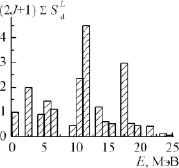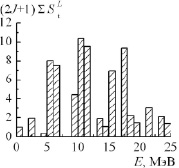The ground and excited states of the 9Be nucleus are considered in this work. Spectroscopic factors of deuterons and tritons in the 9Be nucleus for different states of the nucleus are calculated. The account of the states with Young [441] diagrams in the pickup reaction of tritons and deuterons by the nuclei 6Li and 7Li respectively enriches significantly the excitation spectra in the lithium transfer reactions.
The 9Be nucleus has a specific nuclear structure. Unlike lighter nuclei from a deuteron to 8Be whose wave functions in the shell model are more than 95 % characterized by one predominant configuration, the 9Be nucleus contains no explicitly singled out components. In the many-particle shell model, the wave function of the ground state is composed of 13 components [1], the total contribution of the two components with the [441] Young diagram reaching approximately 96 %. The contribution of the states having the [432] Young diagram does not exceed three per cent. It is quite obvious that the predominant configuration of the 9Be nucleus is the ααn model [2]. It is this model that best describes the properties of the 9Be nucleus. Only this model yields an apt description of the (γ, p), (γ, d), and (γ, t) photonuclear processes on the 9Be nuclear [3] and the hadron elastic scattering reactions at low transmitted pulses [4]. It should be noted that like in the many-particle shell model, the wave function of the ground state in the 2αn model is characterized by three components making approximately equal contributions. The shell configuration with the [432] Young diagram corresponding directly to the {αtd} cluster decomposition correlates to higher excitation energies [1]. At the same time, it was suggested in [5] that the indicated states with the [432] Young diagram be searched for in lithium transfer reactions of types 7Li(6Li, α)9Be and 6Li(7Li, α)9Be (see Fig. 1).
a  b
b
Fig. 1. Diagrams, illustrating the reactions of direct transfer of deuterons (а) and tritons (b) on lithium nuclei
Owing to the low binding energy of 7Li in the α + t channel and of 6Li in the α + d channel, the predominant mechanisms are in both cases the transfer of the deuteron and triton clusters, respectively. The flexibility of the many-particle shell model, however, is that the [441] Young diagram presumes deuteron and triton escape, since (according to Littlewood’s rule) decompositions  and
and  are possible [5]. For a more comprehensive description of the above mentioned lithium reactions, not only the states of the 9Be nucleus with the [432] Young diagram must be considered, but also the states with the [441] diagram. The spectroscopic factors in the 6Li + t and 7Li + d channels including both the [441] and [432] Young diagrams were calculated by the authors. In the transfer reactions, the excitation cross section σ of the levels of the residual nucleus (9Be in this case) can be represented by the expression
are possible [5]. For a more comprehensive description of the above mentioned lithium reactions, not only the states of the 9Be nucleus with the [432] Young diagram must be considered, but also the states with the [441] diagram. The spectroscopic factors in the 6Li + t and 7Li + d channels including both the [441] and [432] Young diagrams were calculated by the authors. In the transfer reactions, the excitation cross section σ of the levels of the residual nucleus (9Be in this case) can be represented by the expression  assuming a direct mechanism in which SL are corresponding spectroscopic factors and Φ is a factor depending on the kinematic characteristics. Assuming that Φ is a more or less smooth value in dependence on energy, the peaks observed in the reactions must be related to the peaks of the spectroscopic factors.
assuming a direct mechanism in which SL are corresponding spectroscopic factors and Φ is a factor depending on the kinematic characteristics. Assuming that Φ is a more or less smooth value in dependence on energy, the peaks observed in the reactions must be related to the peaks of the spectroscopic factors.
The calculated values of the spectroscopic factors are shown in Table 1. The same values are presented in Fig. 2 as histograms comprising the sums of the S-factor values within an energy range of 1 MeV. A comparison with experimental data of [6] shows that the theoretical study correctly represents the main peaks at energies E = 11,8; 15,2; 17,8, and 22 MeV. There are also moderate peaks at E = 0 and 3 MeV resulting from the [441] Young diagram.
Spectroscopic factors of deuterons and tritons in the 9Be nucleus for different states of the nucleus
|
Levels of 9Be |
|
|
|
|
|||
|
ΔE*, MeV |
J, T |
L = 0 |
L = 2 |
L = 1 |
L = 3 |
7Li + d → 9Be* |
6Li + t → 9Be* |
|
0–2 |
3/2,1/2 |
3,6·10–2 |
3,7·10–1 |
9,0·10–2 |
8,2·10–4 |
1,00 |
1,00 |
|
2–3 |
3,1 |
2,3·10–2 |
8,0·10–1 |
9,1·10–2 |
7,5·10–2 |
2,00 |
1,93 |
|
4–5 |
3/2,1/2 |
4,3·10–2 |
3,3·10–1 |
2,8·10–2 |
2,8·10–3 |
0,92 |
0,34 |
|
5–6 |
5/2,1/2 |
2,9·10–3 |
3,9·10–1 |
3,8·10–3 |
4,8·10–1 |
1,44 |
8,04 |
|
6–7 |
7/2,1/2 |
2,2·10–1 |
3,3·10–1 |
1,10 |
7,48 |
||
|
9–10 |
5,1 |
1,7·10–1 |
1,7·10–1 |
6,4·10–1 |
3,3·10–2 |
0,44 |
4,46 |
|
10–11 |
5,1 |
5,0·10–1 |
3,0·10–1 |
6,2·10–1 |
1,6·10–1 |
2,36 |
10,36 |
|
11–12 |
6,1 |
5,7·10–1 |
5,4·10–1 |
5,5·10–1 |
1,7·10–2 |
4,50 |
9,48 |
|
13–14 |
5/2,1/2 |
6,4·10–2 |
2,6·10–1 |
6,1·10–2 |
5,4·10–2 |
1,19 |
1,90 |
|
14–15 |
3/2,1/2 |
4,1·10–2 |
2,0·10–1 |
4,6·10–2 |
4,8·10–2 |
0,61 |
1,04 |
|
15–16 |
5,1 |
1,0·10–1 |
1,4·10–1 |
1,8·10–1 |
2,1·10–1 |
0,54 |
6,96 |
|
17–18 |
8,2 |
1,1·10–1 |
9,7·10–1 |
2,1·10–1 |
4,4·10–1 |
2,96 |
9,34 |
|
18–19 |
3/2,1/2 |
3,3·10–2 |
1,9·10–1 |
1,9·10–1 |
5,9·10–3 |
0,55 |
2,20 |
|
19–20 |
5/2,1/2 |
5,4·10–3 |
1,1·10–1 |
3,9·10–3 |
9,0·10–2 |
0,43 |
1,49 |
|
21–22 |
13/2,3/2 |
4,1·10–3 |
2,3·10–1 |
1,3·10–2 |
1,6·10–1 |
0,41 |
3,04 |
|
23–24 |
17/2,3/2 |
1,3·10–3 |
3,3·10–2 |
4,1·10–3 |
1,1·10–1 |
0,13 |
2,12 |
|
24–25 |
2,1 |
2,5·10–2 |
5,5·10–3 |
3,8·10–2 |
3,3·10–5 |
0,05 |
1,42 |
a  b
b
Fig. 2. Excitation spectrum of the 9Be nucleus in reactions: а –7Li(6Li, α)9Be; b – 6Li(7Li, α)9Be
The three-cluster states of αtd nature can be correlated not only with the orbital [432] Young diagram but also (with no less certainty) with the [441] Young diagram. It is therefore not surprising that the authors managed to provide a successful description of the (γ, d) and (γ, t) photonuclear processes in the 9Be nucleus by using the ααn-model [3].
The ground state of the 9Be nucleus has the wave function with the dominant Young [441] diagram, corresponding to the cluster {ααn} decomposition. The potential three-body model explains also the channels with escape of neutrons, protons, tritons, deuterons and α-particles. The component of the wave function with Young [432] diagram, corresponding to the cluster {αtd} decomposition, is a small impurity to the wave function of the ground state. Particularly, the cluster αtd-model does not admit the observable in an experiment the escape of neutrons with forming of the ground and the first excited states of the 8Be nucleus, whose wave functions are characterized by Young [44] diagram. The states having αtd-nature, in main are highly excited states of the 9Be nucleus. In αtd-model it is not possible to observe an escape α-particles with forming of the 5Be nucleus, having in the ground state the Young [41] diagram.
The work is submitted to the International Scientific Conference «Implementation of integrated model of educational institutions, implements educational programs different levels of education», Republic of Singapore, December, 10-17, 2013, came to the editorial office оn 18.11.2013.





